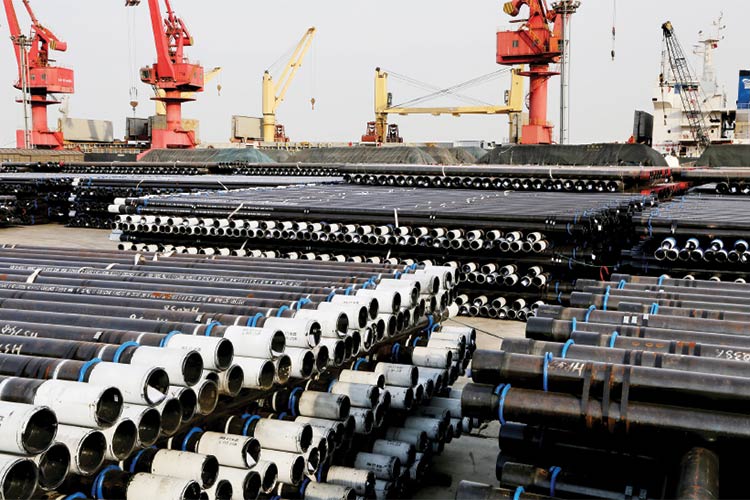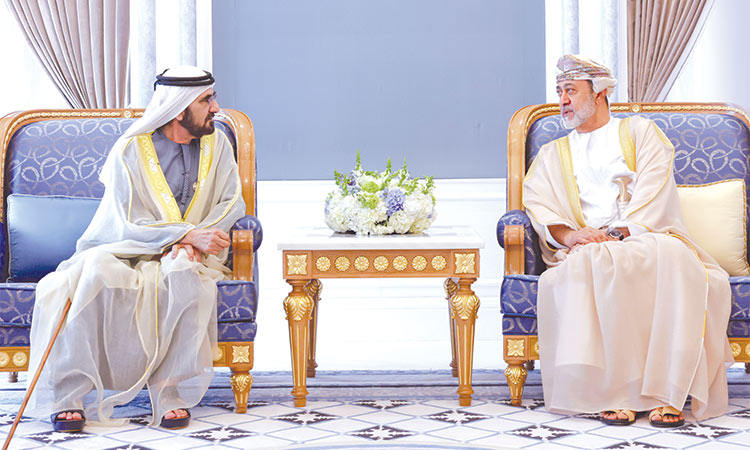Beijing’s production restrictions affect global steel dealers

Steel pipes for exports at a port in Lianyungang, China. Reuters
The steel market is having to weigh news of extended output restrictions as part of ongoing efforts by Beijing to lower air pollution, weak vehicle sales, slower economic growth and uncertainty over the trade dispute with the United States.
If that sounds negative for prices, consider the upcoming peak-demand season as winter ends and construction projects kick off, increased stimulus spending on infrastructure and the view that lower output may support a supply-driven price increase.
For iron ore there is the ongoing challenge to work out whether the terrible tailings dam disaster in January at a mine operated by Brazil’s Vale will actually cut exports by enough to make a difference.
And if it does make a difference, will it also have an effect on high-grade versus low-grade iron ore demand?
The market also needs to reconcile the increase in port stockpiles of iron ore, even though shipments from Port Hedland, the main export harbour in top producer Australia, actually fell in February.
Amidst all the noise it’s sometimes safest to seek solace in hard data, while still keeping an eye on developments in what could be termed sentiment drivers.
The first fact worth noting is that China, which produces just over half of the world’s steel, hasn’t really slowed output of the metal much, despite considerable media reporting of pollution restrictions.
Output in January was 75 million tonnes, which was down from 76.12 million tonnes in December, but was also up 4.3 per cent from the same month in 2018.
The numbers suggest that while steel production has moderated somewhat, the winter production curbs haven’t had a dramatic impact, although it’s worth noting that February’s output numbers are still to be released.
The price of benchmark steel rebar futures in Shanghai has also tracked sideways since ending at 3,856 yuan ($575) a tonne on Feb. 11, which was the highest close in nearly four months.
At the same time, iron ore has retreated, with Dalian Commodity Exchange futures falling from their closing peak of 651.1 yuan a tonne on Feb. 11 to 601 yuan on Monday.
The record-high was reached in the wake of the Vale dam disaster as the market fretted about supply, but so far this concern hasn’t shown up in import figures.
China imported 19.97 million tonnes from Brazil in February, according to vessel-tracking and port data compiled by Refinitiv, which was higher than January’s 19.74 million, and considerably more on a daily basis given February was three days shorter.
Given the sailing time of around six weeks from Brazil to China it might be more reasonable to expect any impact on imports only to show up in March and subsequent months, but the evidence so far is mixed.
Refinitiv data shows 7.2 million tonnes of Brazilian iron ore was offloaded in the first 11 days of March, a daily rate that would put the whole month at around 20.3 million tonnes.
If the March outcome is around the 20 million tonnes mark, it suggests that Brazil is having little difficulty in exporting iron ore to China, despite the closure of some operations in the wake of the dam failure.
In fact, the weakness in China’s February iron ore imports was all down to a sharp fall in shipments from Australia, which dropped to 49.26 million tonnes from January’s 60.17 million.
There were some weather-related delays at export ports, and the Refinitiv data suggests that Australia’s shipments to China will lift in March to around 52.1 million tonnes.
The spot price of iron ore in China has retreated from recent highs, with the 62 per cent grade, as assessed by Argus Media, falling to $83.55 a tonne on Monday, down 8.2 per cent from a year-high of $90.75 on Feb. 11.
The 58 per cent grade has actually fared slightly worse, declining by 8.5 per cent to $74.05 a tonne on Monday from $81 on Feb. 11.
Ultimately the signals from both the iron ore and steel markets in China appear to be that more certainty is needed on the demand outlook before prices can lock in a definitive direction.
In the meantime it would seem that adequate iron ore supplies and concern over the steel demand outlook will be enough to ensure that prices are more likely to drift lower than enjoy a sustained rally.
Meanwhile, new home prices in China grew at their slowest pace in 10 months in February in sign of slackening demand as the economy cools further, leaving authorities walking a tight rope between loosening some existing curbs and flushing out speculators.
Consumer and business confidence has slipped over recent quarters in the wake of heightened economic uncertainty and a yet-unresolved Sino-US trade dispute, discouraging residential investment.
Reuters



